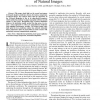Free Online Productivity Tools
i2Speak
i2Symbol
i2OCR
iTex2Img
iWeb2Print
iWeb2Shot
i2Type
iPdf2Split
iPdf2Merge
i2Bopomofo
i2Arabic
i2Style
i2Image
i2PDF
iLatex2Rtf
Sci2ools
109
click to vote
ICIP
1999
IEEE
1999
IEEE
Edge Directed Prediction for Lossless Compression of Natural Images
This paper sheds light on the recent least-square (LS)-based adaptive prediction schemes for lossless compression of natural images. Our analysis shows that the superiority of the LS-based adaptation is due to its edge-directed property, which enables the predictor to adapt reasonably well from smooth regions to edge areas. Recognizing that LS-based adaptation improves the prediction mainly around the edge areas, we propose a novel approach to reduce its computational complexity with negligible performance sacrifice. The lossless image coder built upon the new prediction scheme has achieved noticeably better performance than the state-of-the-art coder CALIC with moderately increased computational complexity.
Adaptive Prediction Schemes | ICIP 1999 | Image Processing | LS-based Adaptation | Prediction Scheme |
Related Content
| Added | 03 Aug 2010 |
| Updated | 03 Aug 2010 |
| Type | Conference |
| Year | 1999 |
| Where | ICIP |
| Authors | Xin Li, Michael T. Orchard |
Comments (0)

